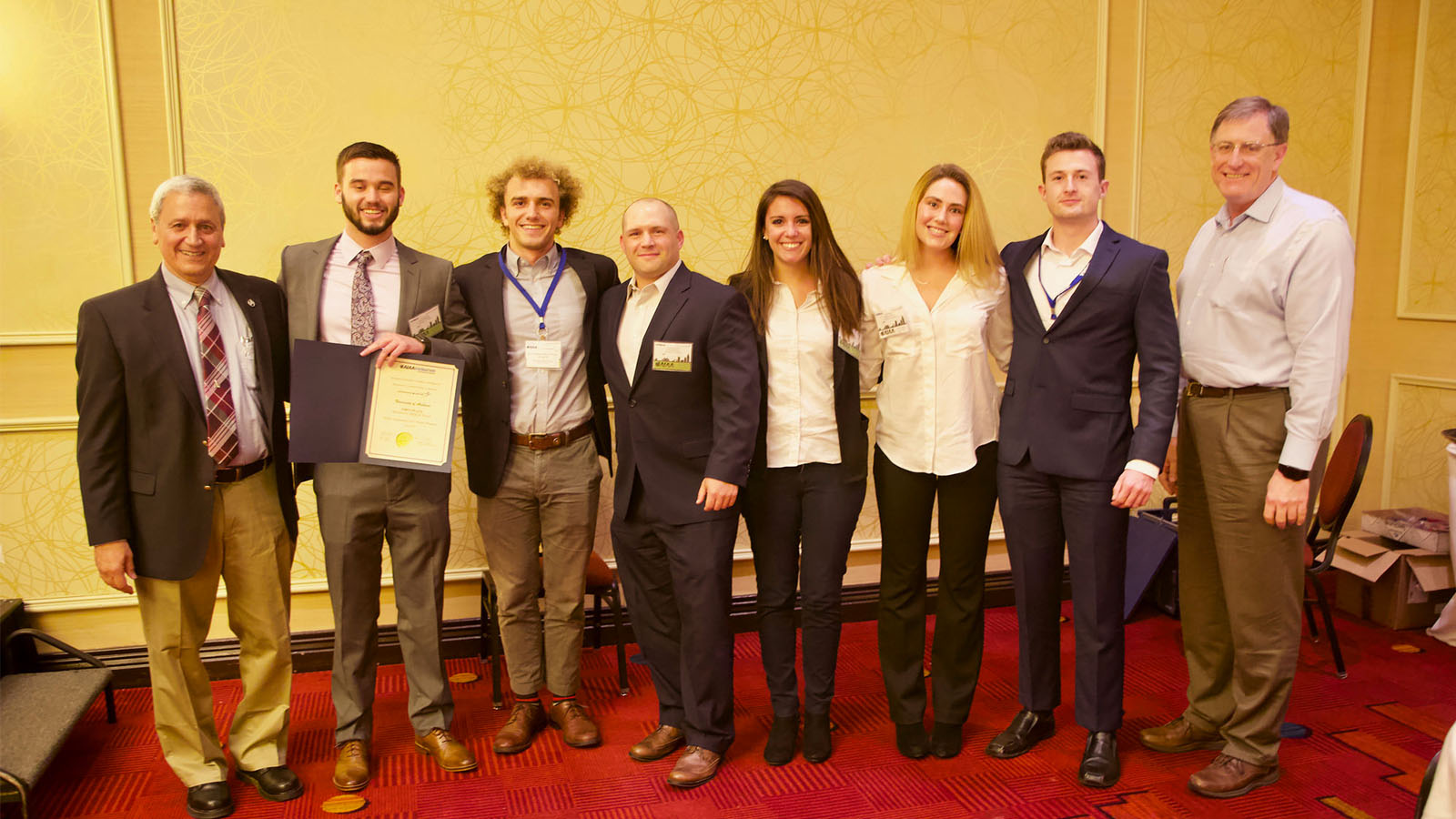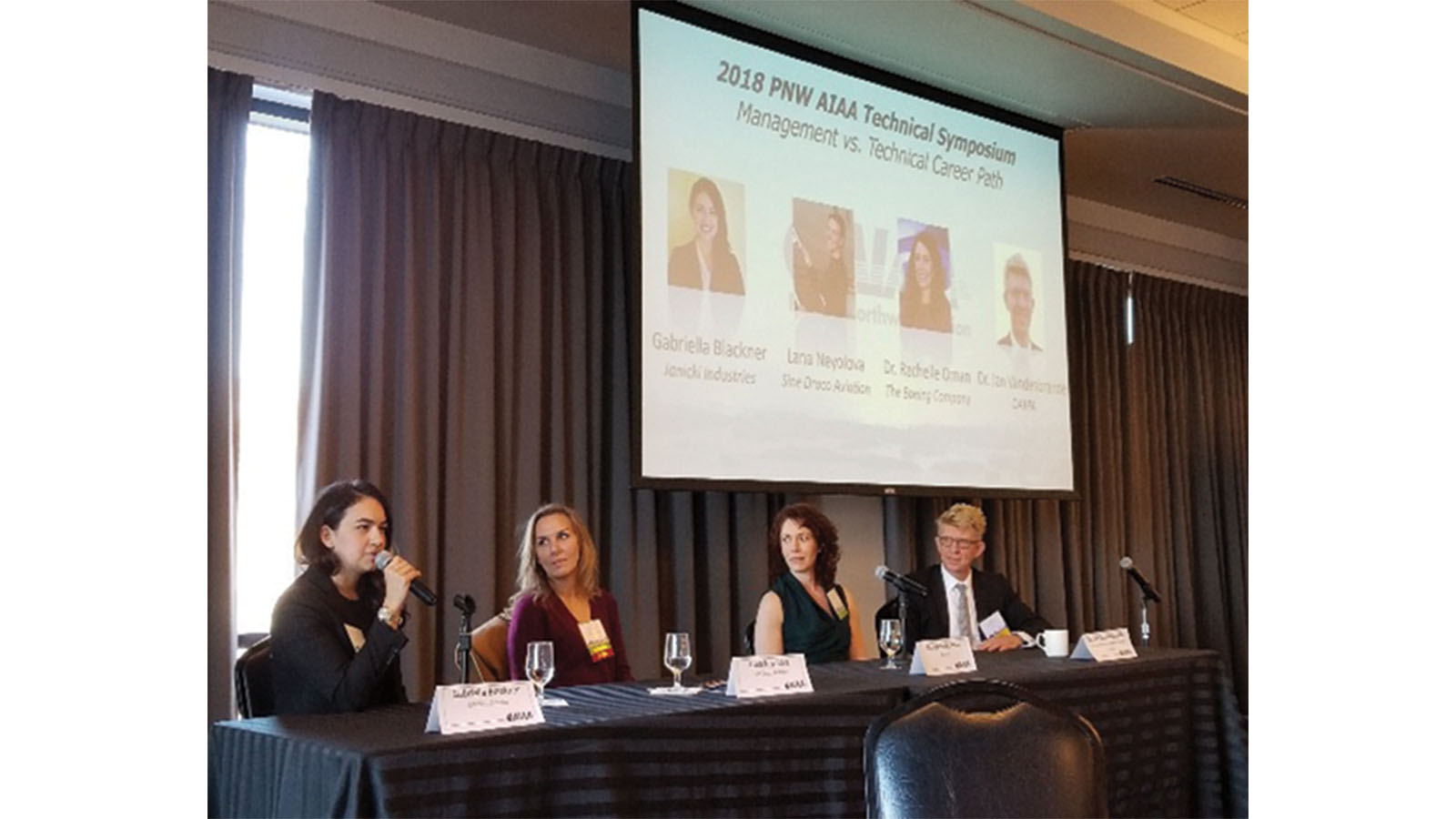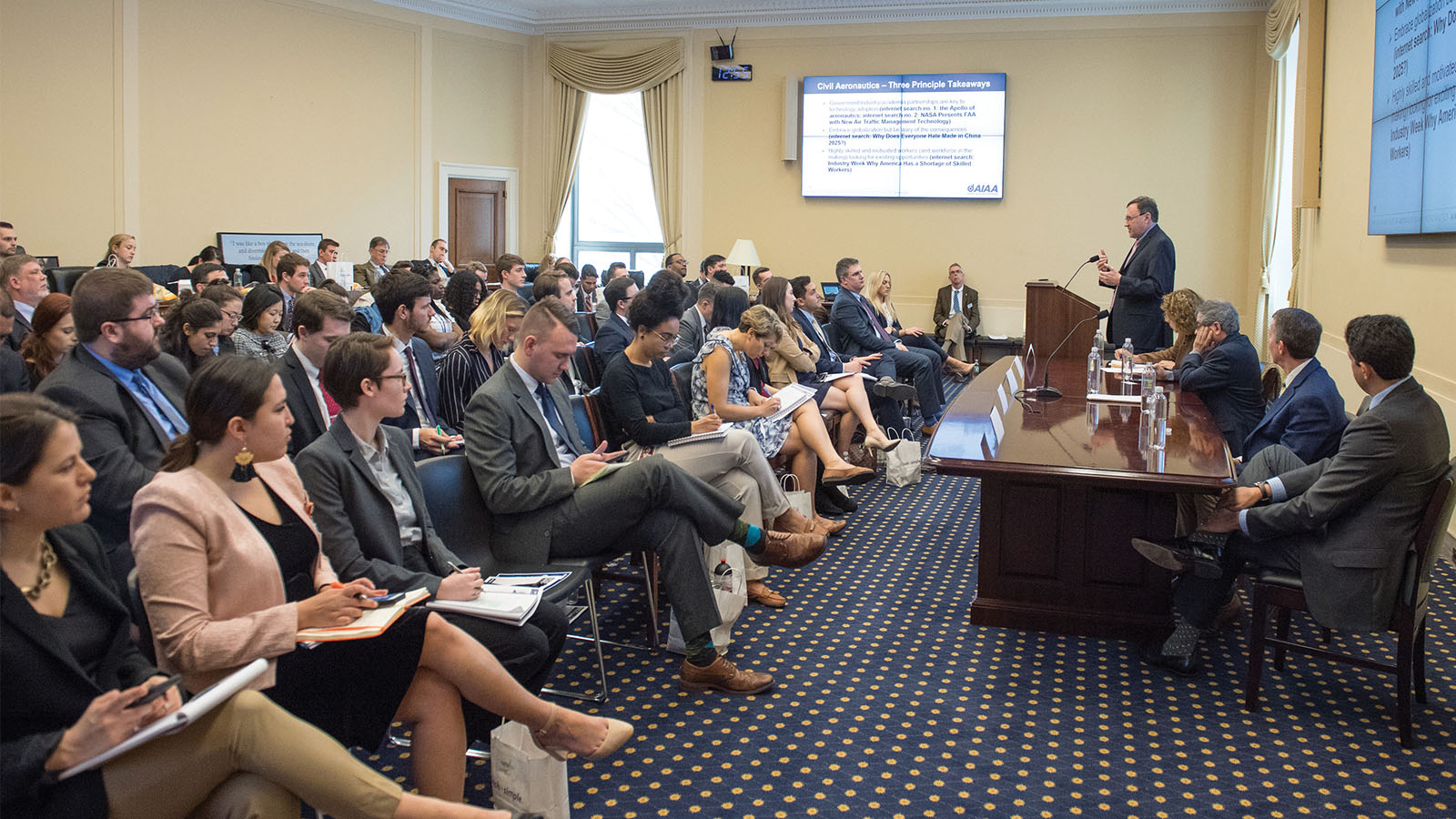Stay Up to Date
Submit your email address to receive the latest industry and Aerospace America news.

Making an Impact: AIAA Regional Student Paper Conferences
AIAA Regional Student Paper Conferences are the first time for many students to get professional feedback on their research and presentation style. It’s a big first step on what, we hope, is a long career path that expands what we know about the world and beyond it.
The AIAA Foundation annually supports six Regional Student Paper Conferences held throughout the United States, plus one in Australia, and an International Student Conference. We encourage AIAA members to reach out to student branches.
The 2019 student conference schedule is: 29–31 March in Austin, TX, for Region IV; 4–5 April in Cocoa Beach, FL, for Region II; 4–5 April in Minneapolis, MN, for Region V; 5–7 April in Cleveland, OH, for Region III; 5–6 April 2019 in College Park, MD, for Region I; and 6–7 April in San Luis Obispo, CA, for Region VI. Region VII (Australia) will take place in November 2019.
For more information on donating and making a difference in students’ lives, please visit aiaafoundation.org.

12th AIAA Pacific Northwest Annual Technical Symposium
By Agnes Blom-Schieber, 2018 Technical Symposium Co-Chair
The annual technical symposium organized by the AIAA Pacific Northwest (PNW) Section has been a popular event that local members start to look forward to as soon as the previous symposium is done. Every year we try to build on past year’s successes, while expanding the program with new items to increase the variety and keep the symposium interesting year after year.
On 10 November, the 12th annual symposium took place at the Museum of Flight in Seattle and attracted about 170 attendees, a quarter of whom were high school and college students. The program included our traditional components such as plenary lectures, technical presentations, panel sessions, and speed mentoring, while we added a student poster session and resume writing workshop in the Rising Leader’s session. Both the technical and the interactive sessions received very positive feedback from our participants. We received thank you notes from all our Raisbeck High School students with positive feedback that summarized the event. Below are a couple of quotes from their notes:
• “During the symposium I was introduced to some amazing people who inspire me to continue my path as a pilot. Without their words of wisdom, I may have lost confidence in myself.”
• “I learned a lot about careers I would like to go into, as well [as] have gained a lot of helpful advice.”
• “I learned a lot of new information as the talks were super interesting.”
• “It’s definitely an event I’m looking forward to next year.”
• “I had a great time there and particularly enjoyed DARPA and Go Fly’s presentations.”
The symposium was opened by Dr. Jan Vandenbrande, Defense Sciences Office program manager at DARPA (Defense Advanced Research Projects Agency), who shared some of the groundbreaking research that is being performed with DARPA funding across the country. He discussed the Fundamental Design (FUN Design), Transformative Design (TRADES), and Tailorable Feedstock and Forming (TFF) projects, all aimed at revolutionizing design and manufacturing processes.
Next, the audience had a choice between three parallel sessions, two of which featured technical presentations on the Boeing Advanced Research Center, the importance of end user inputs for the ISS, induced drag of aircraft, smart materials, and design and simulation of the LEO CubeSat constellation. In addition, Lane Slagle, officer and active member of our PNW Section, got to talk about our STEM outreach program and encourage members to contribute to future activities. The Rising Leader’s (RL) session was kicked off with a very interesting presentation on systems engineering fundamentals by Adam Wuerl, director of Advanced Concepts and Strategy at Blue Origin. After a short coffee break the RL session continued with a student poster session with contributions from the following teams: Society for Advanced Rocket Propulsion, Autonomous Flight Systems Laboratory, Washington Superbike, North Seattle Community College Rocket Team, and the Advanced Composites team.
At the same time, on the main podium we had a panel session with representatives from three start-up companies: Echodyne, Space Enterpreneurs, and Synchronous. This was the second time the start-up panel was on the program, after a successful introduction at last year’s symposium.
Dr. Bob Winn, a Fellow of both AIAA and the Royal Aeronautical Society, made a special guest appearance as our lunch keynote speaker. He educated the audience about novel techniques used in aircraft accident reconstruction, some of which include using videos shared on social media!
Other afternoon lectures encouraged people to develop near-VTOL personal flying devices capable of flying twenty miles while carrying a single person as part of the Go Fly Prize, shared students’ lessons learnt while building a carbon-fiber amateur rocket, and educated them on how to weld in space.
In the Rising Leader’s session young professionals had a chance to interact with industry experts and ask them questions regarding their career choices, experiences, and anything else they were curious about. Then two wonderful volunteers led a resume-writing workshop for the first time ever at our symposium.
Two other highlights this year were the panel session on the “Management versus the Technical Career Path” and the closing keynote of the day by Brett Smith, CEO of Propeller Airports, who briefed the audience about the latest developments on introducing commercial flights at Paine Field.
Reflecting back on another successful symposium we are already starting preparations for next year’s symposium on 16 November at the Lynnwood Convention Center.
Of course we couldn’t have done this without a fantastic team of volunteers, as well as our sponsors: Ed Wells Partnership, The Boeing Company, Aerojet Rocketdyne Foundation, and Mr. John Somerville.
We are looking forward to next year and would like to invite anyone interested in presenting, sponsoring, or contributing in any other way to take a look at pnwaiaa.org/ts2019/ or contact the symposium chair at [email protected].

Aerospace 101
On 6 February, AIAA sponsored an educational briefing covering the importance of government investment in aerospace and its potential to effect the aerospace industry and the nation’s economy. Approximately 90 congressional staffers from the House and Senate attended the briefing, which was hosted by the House Aerospace Caucus. No specific programs or priorities were promoted.
Panelists included:
• Dr. Bobby Braun, Dean of Engineering and Applied Sciences, University of Colorado Boulder
• Mr. Mike French, Senior Vice President for Commercial Space, Bryce Space and Technology
• Mr. Tom Irvine, Aerospace Consultant
• Dr. Mark Lewis, Director, Science and Technology Policy Institute, Institute for Defense Analyses
• Dr. Sandy Magnus, Former Executive Director, AIAA (moderator)

Society and Aerospace Technology Integration and Outreach Committee at AIAA SciTech Forum
By Dr. Amir S. Gohardani, SAT IOC, Chair
During the 2019 AIAA SciTech Forum, the Society and Aerospace Technology Integration and Outreach Committee (SAT IOC) was involved in a number of activities from chairing papers on reenergizing the U.S. space nuclear power generation to astrosociology and the search for technosignatures. SAT IOC also hosted an inspiring panel session called From Functional to Inspirational Aerospace Art: STEM to STEAM. The goal of this session was to demonstrate how aerospace art is used to visualize advanced concepts, communicate technological advances, build cohesive teams, document historic events, and how it can impact the STEAM classroom.
This session was moderated by Cam Martin, who in his Robert McCall Tribute provided an interesting historical journey and set the stage for engineering as a visual art. The nonverbal thought in technology then transformed into visual problem solving through illustrated examples of Dick Whitcomb and the Area Rule. Additional historical milestones observed took the audience to the nonverbal transmission of mechanical knowledge and Leonardo DaVinci’s sketchbooks before providing a visual inspiration by means of Walt Disney’s “Man in Space” 1955 program with Wernher von Braun.
Following this opening, the panel continued to share their experiences. Aldo Spadoni shed light on how advanced concepts could be visualized by providing examples of his art in aerospace engineering and the entertainment industry. An overall objective of his talk revolved around providing engineers with a feel for a problem through visualization. Artist and research pilot Mark Pestana emphasized the role of the arts in documenting historical events and the power of the arts in team building that he consistently had observed through his patch and logo designs. Sara Brown, an aerospace STEAM education director, discussed the benefits of the arts in the classroom and illustrated how STEAM could take advantage of the ability to visualize and to communicate ideas. Conclusively, SAT IOC committee member Michelle Rouch showcased encouraging examples of continuing the quest to use visual arts with students and her success stories of supporting AIAA sections and larger communities with a variety of STEAM endeavors.

AIAA Associate Fellow Addy Died in November
Alva LeRoy “Tad” Addy died on 16 November 2018 at the age of 82.
Professor Addy graduated with a degree in mechanical engineering from South Dakota School of Mines & Technology in 1958. While working for General Electric he earned a Master of Science degree from the University of Cincinnati in 1960. In 1963 he received a Ph.D. degree from the University of Illinois at Urbana-Champaign, where he then joined the faculty of the Department of Mechanical and Industrial Engineering.
From the earliest landmark publications of his research findings he held an international reputation in the fluid dynamics research community. The U.S. Army Research Office funded the research of Professor Addy and his colleagues at the University of Illinois at Urbana-Champaign continuously for more than three decades. His research was applied to many aircraft, missiles, and rockets including the Space Shuttle and the Concorde.
In addition to being a successful researcher, he was an award-winning teacher at Illinois. Professor Addy’s enthusiasm for teaching and support of multidisciplinary student projects made him popular among undergraduates. In 1993, the University of Illinois College of Engineering students selected him as an Honorary Knight of St. Patrick. A Fellow of the American Society for Engineering Education, in 1990 he was honored with the society’s Ralph Coates Roe Award for outstanding teaching and notable contributions to the engineering profession.
Professor Addy also served as department head for the Department of Mechanical and Industrial Engineering from 1987 to 1998, and during this time he had a profound impact on the department’s direction. Guiding the quality of education provided, research conducted, and public service completed, he influenced the careers of thousands of engineers. During his tenure, the department was consistently ranked among the best in the nation. Further, he contributed to the field of engineering through work with professional societies. A Life Fellow of the American Society of Mechanical Engineers, in 2006 he was named an Honorary Member, which is that society’s highest honor. In retirement he served for a number of years as a Trustee of the South Dakota School of Mines & Technology Foundation.

AIAA Fellow Hassan Died in January
Dr. Hassan Ahmad Hassan, 87, passed away on 12 January. Born in the village of Tamra in Palestine, Dr. Hassan spent the vast majority of his professional career as a Professor of Mechanical and Aerospace Engineering at North Carolina State University (NCSU) (July 1962–July 2018), making him the longest tenured professor in the history of NCSU.
He received his B.S. in Mathematics from the University of London in 1952 (via the University of Baghdad) and then attended the University of Illinois where he received his M.S. in Aeronautical Engineering in 1953 and his Ph.D. in Aeronautical Engineering in 1956. After completing his graduate studies, he held teaching positions at the University of Baghdad and Virginia Tech before joining NCSU as a full professor in 1962.
In 1964, NCSU’s Bachelor of Science in Aerospace Engineering was created and Dr. Hassan led the aerospace faculty in developing a national reputation in aerospace research that is second to none. He was among a distinguished group of faculty who formed the program’s CFD center and later the Mars Mission Research Center. In addition Dr. Hassan spent every summer through the early 1990s working at NASA Langley Research Center with students alongside NASA researchers. He played a critical role in the development of NASA’s in-house computational fluid dynamics codes with the focus on predicting transition and separation—features of aerodynamic flow that continue to challenge engineers today.
Dr. Hassan made many professional contributions in the field of aerospace engineering, including being the lead or co-investigator in over 32 research grants with the following agencies: NASA, the Department of Transportation, Sandia National Laboratories, Army Research Laboratory, Air Force Research Laboratories, and the National Institute for Aerospace. Over 100 former graduate students who studied under him during his long and exceptional career carry on his professional legacy. Among his many awards were the 1987 Alcoa Foundation Distinguished Engineering Research Award, the 1991 Alumni Distinguished Graduate Professor, the 1992 NASA Public Service Medal, the 1993 R. J. Reynolds Co. Award for Excellence in Teaching, Research, and Extension, the 1999 AIAA Thermophysics Award, and the 2004 Alexander Holladay Medal for Excellence—the highest honor bestowed on a faculty member by the NC State trustees. In 2015, the Dr. Hassan A. Hassan Distinguished Lecture Series was established through the generosity of Dr. Hassan’s former students and fellow faculty members to honor his contributions to the department and his impact on the aerospace program.
After joining AIAA in 1956, Dr. Hassan was very involved with many AIAA technical committees, including the High Speed Air Breathing Propulsion, the Atmospheric and Space Environments, Fluid Dynamics, Propellants and Combustion, and Thermophysics technical committees. He received the 2007 AIAA Sustained Service Award for his longtime involvement.
Donations may be made to the Prof. Hassan A. Hassan Graduate Award in Aerospace Engineering via www.aiaafoundation.org (include Dr. Hassan Hassan in the “In memory” area) to help carry on his passion for educating the next aerospace professionals from North Carolina State University. North Carolina State University will hold a remembrance celebration of Dr. Hassan’s contributions to the profession this spring at the university in Raleigh, NC. Check the Department of Mechanical and Aerospace Engineering website (www.mae.ncsu.edu) for details as they become available.
AIAA Associate Fellow Wolf Died in January
Jack D. Wolf, 84, died on 13 January.
Mr. Wolf graduated from the University of Wichita with a degree in Aeronautical Engineering in 1957 and received his Master’s degree from the Air Force Institute of Technology in Dayton, OH. He was a Vietnam veteran and pilot in the Air Force. He received two Distinguished Flying Crosses for his acts of heroism. He retired from the Air Force after 21 years and worked as a Safety Manager at Boeing for 18 years.
Stay Up to Date
Submit your email address to receive the latest industry and Aerospace America news.




